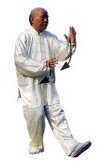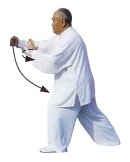My first exposure to the Wu (Hao) style of Tai Chi occurred at the Taiji Forum 2006 conference in Thunder Bay, Ontario. I noticed a few significant differences between its postures and those of the more popular Yang style:

- The stance is shorter and more upright.
- Arm and leg movements are smaller.
- Hands remain in front of the body.
- Both feet rotate simultaneously when turning.
- Movements in the form are repeated to left and right sides.
Wu (Hao) style was developed in the 1800s by Wu Yuxiang, with inspiration from Chen and Yang predecessors. However, based on my limited exposure, it seems equally similar to some schools of Wing Chun. Other conference attendees made similar observations.
Wu (Hao) style can be distinguished from the Wing Chun of Yip Man and his descendants by these characteristics, among others:

- Movements are smooth and circular.
- Armpits are slightly open.
- Weight frequently shifts onto and off of the front leg.
Unfortunately, instructors of Wu (Hao) Tai Chi are few and far between. I think that Wing Chun practitioners who are interested in broadening their horizons will enjoy sampling this style.
I think that the internet could help instructors of similar arts to learn this style. It can be done through people keeping detailed blogs about it, publshing a book on amazon or an ebook with pictures and movement diagrams.
There’s also the posibility of video clips showing movements now.
No way. Wing Chun only uses the knees rotated in stance. Wu (Hao) taiji must rotate the knees out.
In both pictures above , his knees are out. This is a big no-no in WC.
Wing Chun does not only use the YJKYM. Look at the pole form.
In all the chi sao I have seen people do, they are mostly in the toes in stance.
I’d argue that the pole form is for specific power development and that is why it doesn’t necessarily use the turned in horse. I have also seen people do a pole form from a turned in stance as well.
More importantly, wing chun does not use the back bow (straight back in wc), nor does it use the spiraling motion that you see in teh r3al taiji. WC also isolates the upper back. Not that wing chun is bad or anything, just that Wu Style and Wing Chun are worlds apart.
the wing chun and tai chi i study both borrow from (internal) iron body iron palm technique which teaches that the stance is rooted on the nine pionts of the foot (5 toes, 2 balls, ridge, heel). feet are turned in, the knees are bent and pulled together but turned out by opening the pelvis,( spiral energy), the back is kept straight by lifting the head and the elbows stay down to keep the sholders down.
peace and love
I have had some basic WC training and have attended a Wu-Hao class as well. There are some similarities, and they have the same roots (taoist arts/white crane) but there are stronger differences. Many of the similarities are a matter of convergence towards effective means, but not all. Some relate to the same original transmissions.
Hello , I have trained some Wing Chun and have begun learning a Chen Pan Ling form of Tai Chi. Looking at the Lineage this form of Tai Chi appears to have been inspired greatly by the Wu style.
It struck me while practicing the Tai Chi earlier this evening in the park just how many similarities there are between the Ip-man Wing Chun and Chen Pan Ling Tai Chi and if only I paid attention each simarlarity helped me hone much more effective position in stillness and movement. I felt that immediatly upon looking from a wing chun stand point, the Tai Chi form became much clearer to understand easier to learn. In the practical sense I would say it has allowed me to see how effective the Tai Chi is ahead of time.
Applying the understanding picked up from your Wing Chun will aid you no end in learning and developing in this Tai Chi and what a great way to cool down. I hope you try it yourself and see.